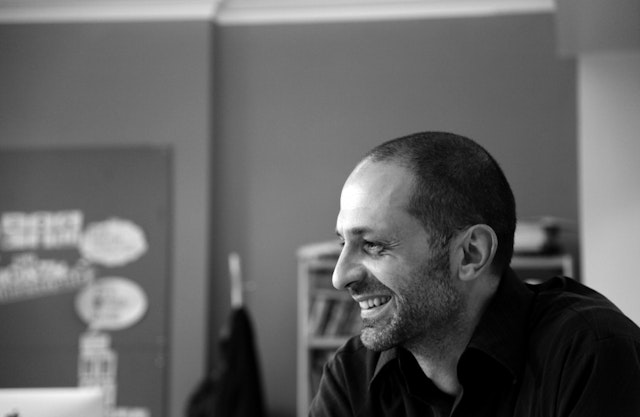As the nominations are announced for The Drum Design Awards, we catch up with the inaugural judging panel to explore how branding is evolving digitally and how brand identities are adapting to remain relevant across ever-changing channels.
Ask yourself this: why does your brand exist?
The digital age has ushered in myriad new ways
for brands to reach their customers; screeds
upon screeds have been devoted to glorifying
the explosion of communications channels at
a modern brand owner’s disposal. But in this new world designers, and the brands
they play a part in creating, have never been under greater scrutiny. Digital demands that brands prove
their relevance like never before. We asked the judging panel of The Drum Design Awards, some of the most accomplished brand builders around, exactly what impact the proliferation of digital
has had on brands and how their industry has changed.
Gion-Men Kruegel-Hanna - global creative director at Imagination
Amongst the many trends that categorise the visual design of an identity, there’s one that stands out the most at the moment: the lack of fresh and new ideas.The digital space provides us with a vast array of opportunities to develop identities in a dynamic and multifaceted way. It provides us with the chance to create distinctive and unique experiences through live storytelling. Yet our industry seems to be continuously reverting back to the same old recipes to cook up bland and nondescript brand identities.And whilst the term ‘digital’ is on everybody’s lips, few new identities make use of the emotional connection that movement, sound, surface and interaction can offer in terms of how we experience a brand in both the digital and physical spaces. Let alone how it tells a coherent brand story. New rules of identification (who’s sending what kind of message to whom) and perception apply, where technology now drives dialogue and interaction with the user, viewer and customer of a brand. But an identity shouldn't succumb to technology and its use – identity has to cater to the needs and desires of a human soul and tap right into where it moves us most: our hearts and minds. Having a great idea is still key. Especially an idea that no one else has already thought of before.
James Sommerville, founder, ATTIK
Our very first ATTIK job was £150 for a logo design. It did the job. Along came the 90’s the new word was a corporate identity which sounded more expensive, so we charged £1,500. It did the job. Today everyone needs a brand so the cost is £150,000. Will it do the job?Was branding new? Or just progression of the decades before?Television is credited with mass branding in the 1950’s, but it was very monologue. They told us something (or our parents) and the audience listened. Then the internet in the 90’s, where customers could have a dialogue with a brand through emails and message boards. Now we have multi-way conversations with hundreds, thousands or even hundreds of thousands of people. Every minute, hour, and every day.Branding is storytelling and that hasn’t changed, but the channels have. Today it just means brands can tell better stories to consumers and via social networks, can allow those stories to be re-told again and again. So the challenge for designers is not to design logo’s but is to create stories. Because technology will evolve and evolve but the human need for a good story will not.Google yourself, check out your brand!
Sophie Lutman, creative director, Lambie-Nairn
It may be controversial, but I don’t think that the explosion of digital has radically altered branding. Brands have had to evolve with and react to their environment, but really successful brands have always been engaging and true to their products and services. Brands are people talking to people, whatever the channel, and that is still true, even in this digital climate. We can’t think of our brands as traditional or digital anymore – all brands need to be applicable across all channels. Your brand will need to be just as powerful on a billboard as on my twitter feed. ‘Logo’ used to be a bit of a dirty word in branding, but if you want to be multi-channel, you need a logo. There’s not much visual real estate on my phone and I need to recognise you fast. Whatever your brand iconography, it still needs to be uniquely you and used consistently.Branding is all about the experience, and the brand identity is the door to this experience – a recognisable point of entry. Designers have a difficult job here. They have to create brands that will remain relevant in an unknown digital future – a single brand that works on a Pebble watch, that can be used on twitter and in print, and can adapt to Google Glass and countless other as yet unheard-of innovations. We’ve seen countless brands over the past decade try to go viral, or create a social media strategy from thin air, but none of it really comes off unless it’s genuine. An intelligent brand will always cultivate a multi-channel identity – look at Apple: a simple logo, great brand consistency, no social media output and one of the most pervasive, talked-about brands in the world. Corporate brands constantly have to adapt to an ever-changing landscape, where no mistake goes unnoticed and an errant tweet can become an international social media sensation within minutes. There’s nowhere to hide in a digital world and, as Warren Buffet says, “It takes years to build a reputation and minutes to ruin it. If you think about that you’ll do things differently”
Sue Daun, managing creative director, The Brand Union
The increase in digital content consumption and magazine style media has changed how we consume brands – we expect the way they represent themselves to be more fluid, to flex and form to adapt to suit the channel or consumer.As brands become more iterative in their nature this shift towards expressive identities is another way for the brand to show its values and for some, this is relevant. This trend, currently seems to have settled itself to categories such as media companies, cultural centres, leisure brands and online retailers etc., with more corporate brands animating the logos rather than delivering the creative freedom demonstrated in some of the more consumer brands. But then do I really want my bank to be flexing its creative muscles when in fact stability and trust are what I feel they should be communicating?Every interaction a consumer has of a brand builds towards the impression they form and of course the logo is just one part of this. As brand builders we aim to ensure every moment of interaction collectively leaves a positive impression and that these impressions are relevant and fitting to the brand. Therefore the same is true of the identity. Whilst a brand is a living organism that needs to continually challenge, provoke and demand more of itself, does provide us with a new way to consider identities and the role they can play in communicating a more engaging visual equity, there is a real fear that it will become the standard approach in to trying to say ‘we are more dynamic and creative’. However, when you experience the brand the message is not embedded in how the brand acts and behaves, ultimately disappointing the consumer and loosing the trust and loyalty that could have been built.
Dan Radley, executive creative director, Start JudgeGill
This is the most exciting moment in history to be a brand designer. Our world is a giant sweet shop.Once upon a time, reputations were fiercely managed - control was everything. Now, consumers are discovering their social superpowers and the only constant is change. Successful brands evolve rapidly, flexing around people’s needs.What does a brand asset even look like these days? It can be as momentous as a skydive from the edge of space or as nuanced as the way a screen refreshes.Brands are created and experienced in the round: they’re 3D not 2D; they move and they move us; they start with a company’s own people and they can be manipulated, owned and shared by all of us.Amidst the change, my one immutable principle – be true to yourself. Identity is still about big ideas and none bigger than a brand’s purpose in society. If we link compelling content to an authentic vision, customers tend to do our reputation management for us. Just like they do the Harlem Shake.
Gary Holt, co-founder, SomeOne
Branding is always evolving, as it is connected to the world of business, commerce and culture. So there is no point talking about specific digital ‘media’. There is a lot talked about ‘brands in the digital world’ and how they evolve, including the ‘rise of the consumer’ thanks to social media – so little can be added to that that is not already out there, and changing daily, by it’s very nature. But brands do regularly now face, and are often not prepared for the question: what’s your reason to exist?It’s all about he rise of the ‘answer’. As we live in an ‘answer-economy’. Brands are more than ever expected to have an point of view. They face their customer relationship moving from broadcast to conversation, from blogs to tweets, being rated to liked, from comment to opinion.And it’s this brand opinion that is vital, not the digital medium. Something that many brands are yet to capitalise on. ‘Media’ are just channels. Being ‘on social media’ is pointless, in fact dangerous unless you’re prepared to get involved, make a point, get things wrong (on occasions), but aim to get more things right. People feel like they own the brand, not the CEO’s after all.So, the medium will always change, but the need for ‘having a reason to exist’, and therefore a point of view hasn’t. Brands have always needed to explain why they’re useful, why they exist – but they’ve been able to mask this through communications. ‘Digital’ has simply made it easier to ask these questions directly. Quicker. More directly. And no answer is well, no answer...
The Drum Design 100 has been announced - check out the ranking agencies online here.












